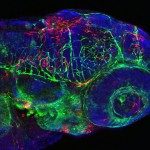Link to Pubmed [PMID] – 17875807
Blood 2008 Jan; 111(1): 132-41
The first leukocytes that arise in the development of vertebrate embryos are the primitive macrophages, which differentiate in the yolk sac and then quickly invade embryonic tissues. These macrophages have been considered to constitute a separate lineage, giving rise to no other cell type. Using an in vivo photoactivatable cell tracer in the transparent zebrafish (Danio rerio) embryo, we demonstrated that this lineage also gave rise to an equal or higher number of neutrophilic granulocytes. We were surprised to find that the differentiation of these primitive neutrophils occurs only after primitive myeloid progenitors have dispersed in the tissues. By 2 days after fertilization, these neutrophils have become the major leukocyte type found wandering in the epidermis and mesenchyme. Like the primitive macrophages, all primitive and larval neutrophils express PU.1 and L-plastin and they are highly attracted to local infections, yet only a small fraction of them phagocytose microbes, and to a much lesser extent per cell than the macrophages. They are also attracted to variously stressed or malformed tissues, suggesting a wider role than antimicrobial defense.




